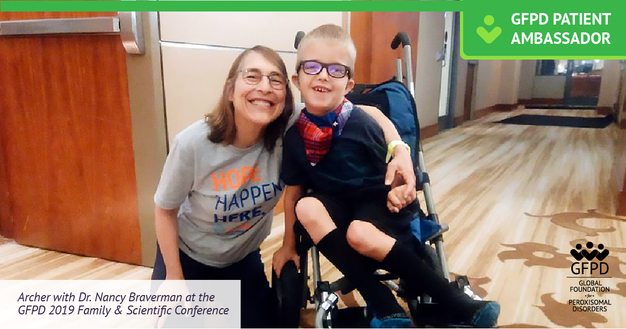
Ashley, mom of 2019 Patient Ambassador Archer, shares their family’s experience of taking Archer for DEXA bone density scans to monitor his bone mineral density.
“The list of ways how peroxisomal disorders can affect children’s health is a long one. Along with feeding/nutrition, liver, hearing, vision, neurological function, teeth, adrenal insufficiency, and kidney issues, children with PBD-ZSD can experience decreased bone mineral density that worsens over time. Although this is a scary possibility because it occurs slowly and can lead to pain, bone fractures, and decreased/loss of mobility (if present), the good news is that successful treatment has been reported using bisphosphonate infusions. Weight bearing activity can also slow the loss of bone density related issues.
As a part of being involved in the GFPD and through the parent support group, we learned about the DEXA (dual-energy x-ray absorptiometry) scan that can evaluate bone mineral density. By the time we began considering a DEXA for Archer, he had experienced a fracture of his clavicle due to a hard fall. This wasn’t necessarily a concern because we knew the cause of the fracture, however, we wanted to get a baseline bone density score to evaluate over time. Our first attempt at the DEXA was not successful because the facility did not specialize in scanning children. Archer was scared and was not able to stay completely still as was required. The technician was not used to working with children as young as Archer.
In 2017 while attending the GFPD conference in Washington D.C. we were able to have the scan completed at Children’s National Hospital. This experience was so different from our first. There was a staff member who brought Archer an iPad to distract him and stayed with him through the procedure. He moved a little, and we had to try a couple times but eventually got the pictures we needed. I forwarded the results to Dr. Eric Rush who is on the GFPD Scientific Advisory Board. Dr. Rush explained to me that Archer’s spine density looked good, however his left hip was low, but fairly typical for PBD-ZSD patients. Because of Archer’s isolated fracture, and his active weight bearing lifestyle, he recommended monitoring of Vitamin D levels but not treatment at that time.
Archer’s second scan was performed again at Children’s National Hospital recently at the 2019 GFPD Family & Scientific Conference. We again had a successful scan and are currently awaiting the results. Because of the GFPD’s hard work to unite specialists to create treatment guidelines on aspects such as bone density in PBD-ZSD patients, and through the experiences of other families in our support group, we can give Archer a better quality of life through consistent monitoring of tests such as the DEXA scan.”
– Ashley, mom of Archer
If you have questions about bone health in your PBD Warrior, please email contactus@thegfpd.org and we can help connect you to our Scientific Advisory Board.
#ZellwegerSyndrome #ZellwegerSpectrumDisorder #PBDWarrior #Bonehealth #Raredisease
